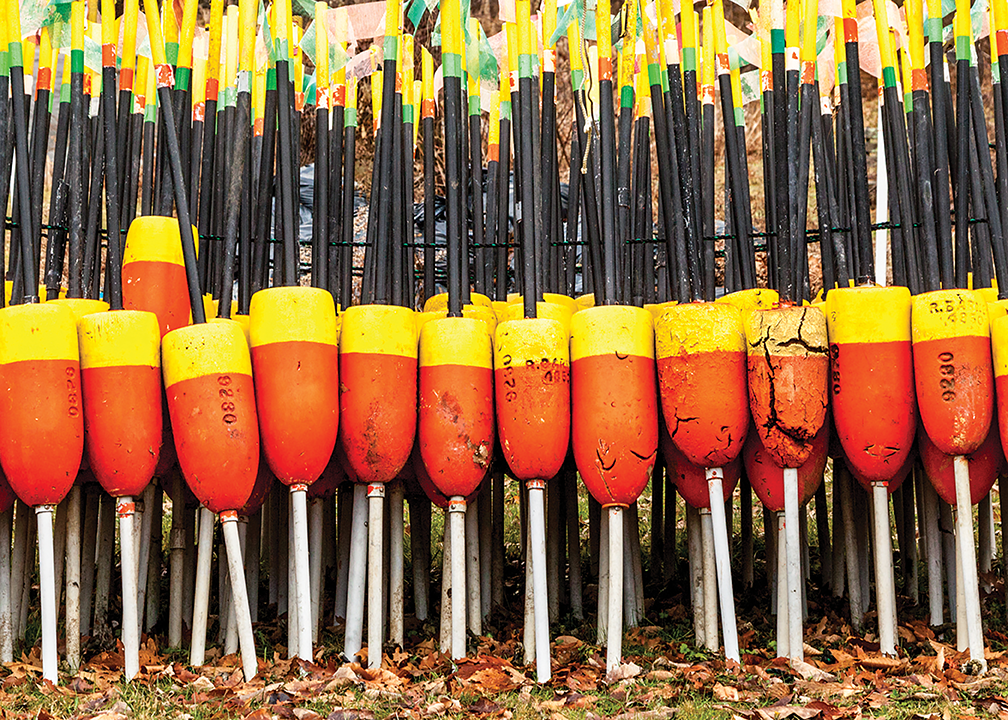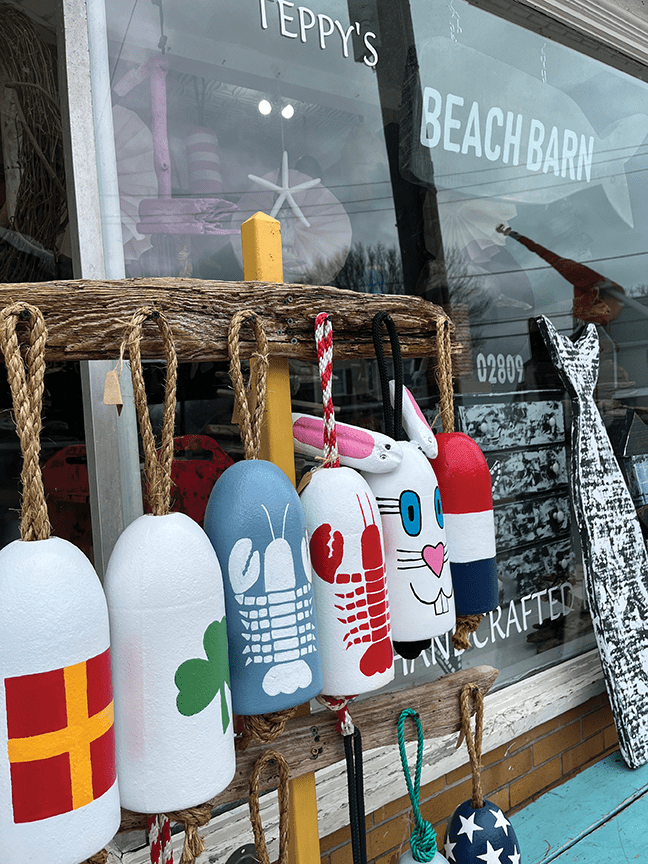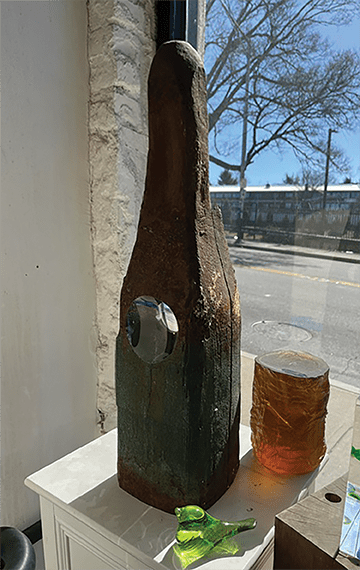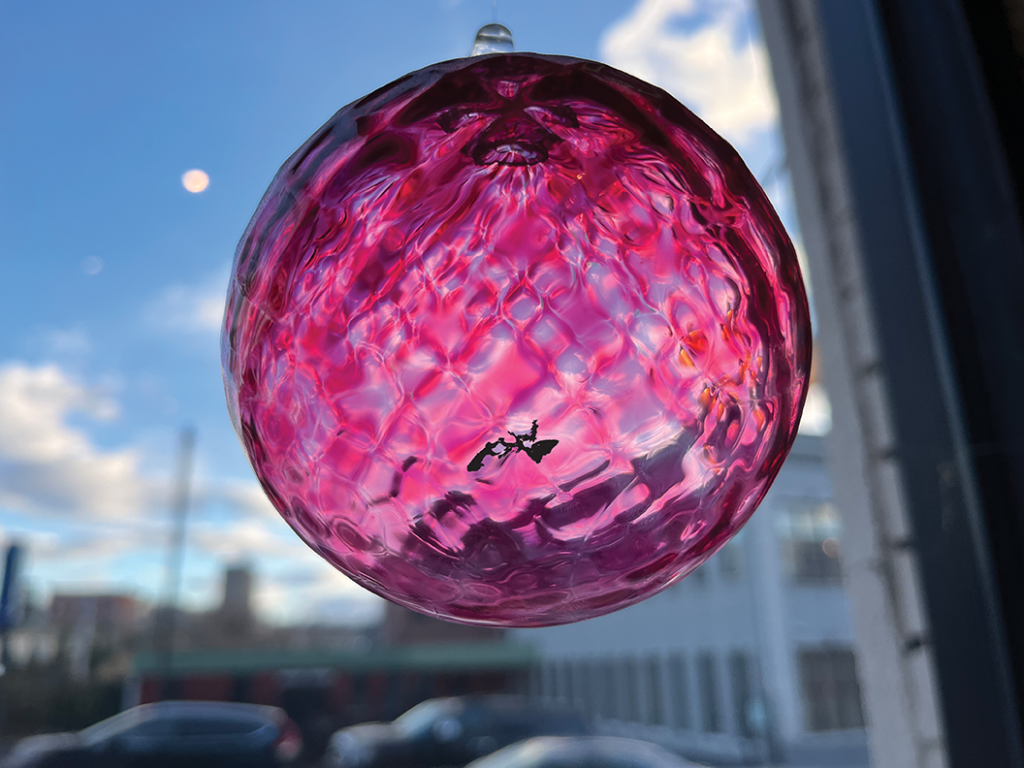
With 384 miles of shoreline, buoys are plentiful in the Ocean State. Buoys are anchored floats strategically perched above shoals or near hazard-prone coastline to help steer sailors. First bobbing to the surface in the thirteenth century as moored rafts or tethered barrels and casks near the Iberian Peninsula, buoys expanded to aid in seafaring navigation throughout Europe and Asia. By the early nineteenth century, Norwegian cod fisherman adopted floats in the form of hand-blown glass orbs tied to gill nets to harvest their catch. Centuries later, buoy uses expanded – thanks to advances in technology, and to account for climate change, pleasure crafts, and commercial boating. Nowadays, buoys are telemetric weather tools, Wi-Fi hotspots, fishery staples, life savers, and even an essential component of nautical home décor.
Local artist, Stephanie “Teppy” Figuerado, started her nautically inspired Teppy’s Beach Barn Art & Gifts store in Warren about four years ago, just 14 days before it was shuttered due to COVID. Now a thriving shop, Teppy’s has become known for her custom-painted buoys featuring various seasonal themes, sold in assorted shapes and sizes. Her collection includes antique wooden, glass, and rescue buoys. Traditional Maine lobster buoys are her favorites: She thinks of them as the maritime equivalent of a family crest, part of family lore passed down through the generations.
“I’ve just loved all things nautical since I was a kid. My grandparents had a beach cottage on Cape Cod, and my gram and I would walk the beach, then come home to make art out of what we found,” Teppy explains, then fondly tells me about the shell seagulls they crafted together.


The Beach Barn also features an array of shell and sea-glass mosaics, fishnet wreaths, boat oars, driftwood signs, and furniture all crafted from beach debris. After years of beachcombing, Teppy knows what she is looking for. “What I pick up speaks to me. I know immediately what I’ll craft with it.” One of her first pieces, a large mermaid mounted on driftwood made primarily of sea-glass, adorns the wall of a Prudence Island summer home.
Vintage glass buoys are hot collector items. They’re often referred to as Japanese buoys due in part to their use in large-scale deep-sea fishing installations miles off the island’s coast. (Fun fact: Some Japanese buoys have been known to reach the shores of the Western US!) These glass globes were made from recycled material and were often peppered with air bubbles. They were made airtight with melted glass stoppers and then tethered to fishing nets to keep the nets afloat; the sunlight reflecting off the glass globes deterred gulls from snatching the catch. Providence-based Gather Glass offers glass blowing classes and also features a type of glass buoy called “witch balls” — glass buoys intended to ward off ill fortune and evil spirits.


Here are a few ways buoys mark the spot:
NAVIGATION
The most common (and oldest) use for buoys is to aid seafarers with navigation. Standardized regulations that dictate color, shape, size, and markings create a universal language that warns seafarers of underwater hazards, controls boating traffic, indicates spots for anchorage and fuel, and even determines speed.
FISHING & LOBSTERING
Originally made of glass (for fishing) or wood (for lobstering), these iconic buoys are now made of Styrofoam and plastic. Bullet-shaped lobster buoys are vital to the life of lobster fishermen as they mark proprietary pots and traps. Specific colors and designs delineate fisheries, and most are handed-down from generation to generation. Some maritime rules require fishing craft carry the buoy insignia on each side of their vessel to ensure against stealing.
WEATHER
Regularly used as meteorological monitors, buoys assist in forecasting seasonal and extreme weather, including hurricanes and cyclones, by measuring air and water temperature, wind speed, barometric pressure, wind direction, wave and water height over oceans, rivers, and lakes. Preventative action mitigates negative impact to homes, businesses, agricultural productivity, water resource management, and off-shore drilling operations.
WARD OFF EVIL SPIRITS
Superstitious fisher wives hung glass fishing buoys — witch balls — in the windows of their homes to keep their husbands safe at sea. Buoyancy and witchcraft were linked in the seventeenth century, when suspected witches were bound and thrown into the water to see if they floated — if they floated they were a witch, if they sank they were not a witch, however, they were also dead.
RESCUE & sWIM BUOYS
Round, donut-shaped buoys of orange and white tossed to swimmers in rescue or life saving situations are found at beaches, pools, and dock-edges. Scuba divers use surface buoys with red flags, to alert boaters of underwater swimmers. White-styled buoys can mark the corners of safe swim areas as well as race courses and seaplane landing zones.
Yes, there are postal buoys – a rarity! In Hamburg, Germany, a postal buoy is launched into Altona’s Holzhafen to commence the annual Harbor Festival in May. Each year, hundreds of postcards are sent from all over the world to the postal buoy, and folks with boats can drop off their letters and cards.
SURVEILLANCE
Buoys are essential monitoring tools for both the military and law enforcement. (Some buoy’s watching you.)
MOORING BUOYS
Permanent mooring buoys, generally ball-shaped with an orange stripe, support sustainable use by preventing anchor damage on sensitive habitats, especially coral and rock formations, and seagrass beds. Dock buoys (also found on the sides of boats) protect vessels from collision.
SOLAR ENERGY BUOYS
Many buoys are already powered by solar panels, so marine-based renewable energy could be promising.
HOME DÉCOR
Nautical-inspired decorations, art, and furniture sometimes made with antique buoys, lend a beachy vibe to homes.
Visit Gather Glass for hand blown glass buoys and witch balls. 521 Atwells Ave, PVD. gatherglass.com
Stop by Teppy’s Beach Barn for decorative buoys — from 4-leaf clovers to pink ‘cure’ ribbons. 17 Water St, Warren. @ beachbarnart


